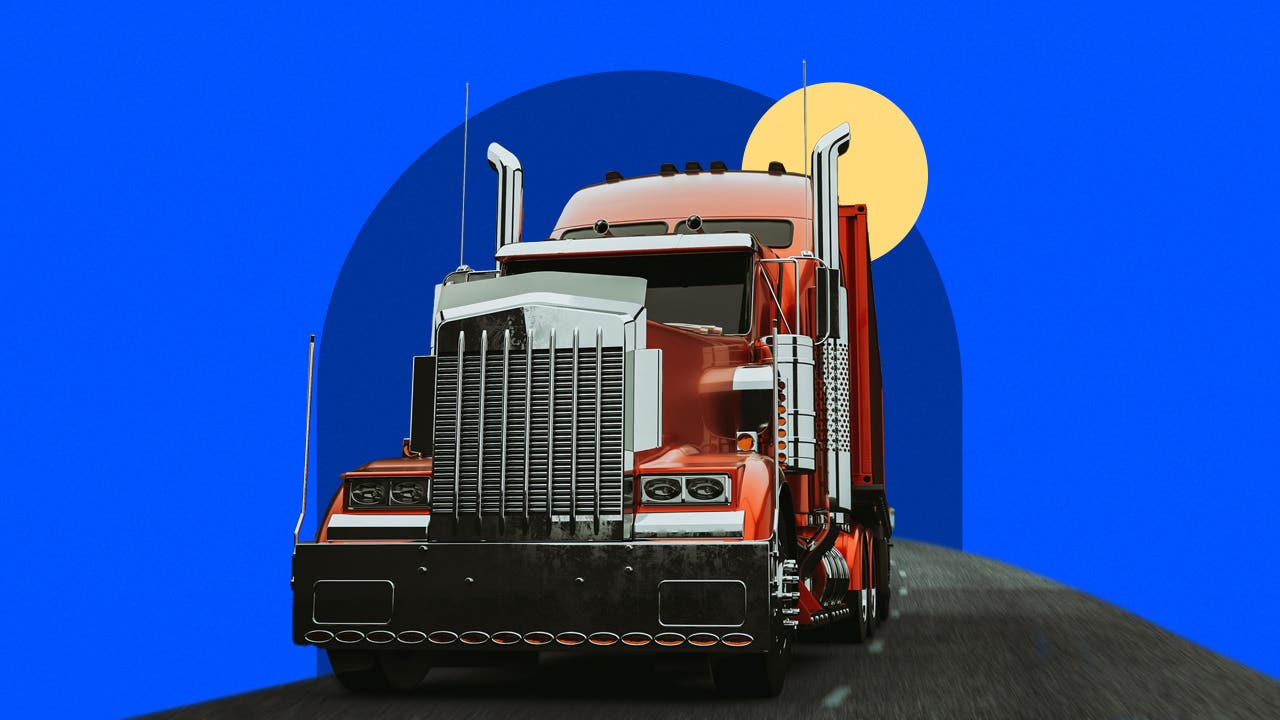Semi-truck financing requirements

The Bankrate promise
At Bankrate we strive to help you make smarter financial decisions. While we adhere to strict , this post may contain references to products from our partners. Here's an explanation for .
Key takeaways
- Your credit score is an important factor when applying for a semi-truck loan, and borrowers with good credit scores can expect lower loan fees and interest rates
- Most lenders require a down payment of up to 30 percent depending on your credit
- Consider both new and used trucks when financing a semi truck — new trucks offer warranties and better mileage, while used trucks may be cheaper and retain value better
Trucks are one of the most important pieces of the American shipping industry, moving more than 72 percent of the nation’s freight by weight, according to the American Trucking Association.
Revenues from truck freight exceeded $875 billion in 2021, making it a highly profitable industry. And most of the industry comprises small business owners and self-employed people, with 95.7 percent of carriers operating 10 or fewer trucks.
If you’re looking to get into the industry or expand your business, a semi-truck loan may be the best way to do it. But you’ll need to meet some requirements to get a loan for a truck.
What are the requirements to buy a semi truck?
When looking to buy a semi truck, there are five requirements to consider.
1. Credit score
When getting any type of loan, including an equipment loan, your credit score plays a huge role. Lenders look at your credit score to get an idea of how you’ve handled credit in the past and how likely you are to default on a loan.
The better your credit score, the easier to qualify for a loan. You’ll have more lenders to choose from, and those lenders will tend to offer lower loan fees and interest rates. All those things mean you’ll spend less money on your loan.
Credit scores of 670 and above are considered good, while those over 740 are very good and give you a good chance of landing the best rates.
It’s possible to get approved for a business loan with bad credit but expect to pay higher rates. Where a borrower with good credit might pay as little as 5.99 percent, someone with bad credit might pay more than 35 percent.
| Lender | Min. credit score | Details |
|---|---|---|
| Bank of America | Not disclosed, but 700 for most Bank of America business loans |
|
| National Funding | 660 |
|
| SMB Compass | 600 |
|
2. Register your business
Many semi-truck lenders will expect you to be operating a shipping business, even if you’re just working for yourself and hiring your services out to other companies. This means you’ll need to register your business, such as forming a limited liability company (LLC) or getting a Doing Business As (DBA) name. The process will depend on your state, so check with your local government for the exact details.
You’ll also need an Employer Identification Number, which you can get for free from the IRS. Some lenders will prefer that you’ve been running your business for a period before you apply. You might find minimum time in business requirements ranging from three months to two years or potentially more.
3. Down payment
To get semi-truck financing, most borrowers will need to pay a percentage of the truck’s price up front as a down payment. The amount of the down payment will depend on your credit score.
Borrowers with good credit scores typically need to provide a 10 percent or 15 percent down payment, though some lenders like U.S. Bank offer equipment loans with no down payment requirements.
Business owners who need semi-truck financing for bad credit may have to provide a down payment of up to 30 percent or higher to help lessen the risk of lending to a subprime borrower. For a $100,000 truck, that could mean providing $30,000 ($100,000 x 0.30 = $30,000) upfront to get a loan.
4. Vehicle
Because the truck you buy serves as collateral for your loan, the lender will want to know about the truck you’re buying when you apply for a loan. Lenders won’t approve your application unless the truck is worth enough to secure the debt.
That means you’ll have to provide info such as the truck’s model, age, mileage and condition. Many lenders have rules about what kinds of trucks they’ll make loans for.
For example, some lenders won’t offer financing for trucks over 10 years old or with more than 700,000 miles on them. Major issues, like a long repair history, could also scuttle a loan deal.
Should I buy a new or used semi truck?
Though lenders might be wary of used trucks, that doesn’t mean buying used is a bad idea. As with anything, there are pros and cons.
Pros of new trucks
- Warranties. Many truck sellers offer warranties on new vehicles.
- Lower maintenance costs. A new truck will need fewer repairs and maintenance than an older one, saving you money.
- Better mileage. Newer trucks tend to get better mileage than old ones, reducing gas costs.
- New technology and amenities. New trucks will have features that older trucks don’t have, such as assisted driving tools and other amenities.
Pros of used trucks
- Lower cost. Used trucks are cheaper than new ones. A new semi truck might cost $120,000 to $150,000 or more, while a used one could cost around $50,000.
- Retains value. New vehicles tend to depreciate quickly. Used trucks will hold their value more effectively.
- Lower insurance rates. Used trucks are worth less, so insurers do not charge as much.
- More data. With older models, there’s more information regarding reliability and any quirks they might have.
5. CDL license
To drive a semi-truck, you’ll need a commercial driver’s license. Many lenders won’t let you borrow money to buy a truck you cannot drive, so make sure to have a CDL before applying.
6. Proof of insurance
Your truck is an expensive investment, but more importantly, to the lender, it’s the collateral for your loan. You’ll need to provide proof of insurance before you finalize your loan. In addition to any specialized insurance for a semi truck, a lender will want to know that you also meet your state’s minimum requirements for insurance.
Some of the coverage you may need includes:
- Primary liability. This pays for damage and injury your truck causes, and you’re liable for.
- Physical damage. This pays for damage to the vehicle if it gets damaged.
- Bobtail coverage. This covers things that happen while driving the truck without a trailer.
- Cargo coverage. This insures the items you are hauling against damage and loss.
What to do if you can’t afford a semi-truck loan
If you’re struggling to afford a loan for a semi-truck, there are a few alternatives to consider.
- Rent a truck. You can rent semi-trucks for a short period. This allows you to take on jobs and try to turn a profit without the large expense of buying a truck.
- Lease a truck. Leasing is a more long-term rental. It’s cheaper than buying in the short term, making it a good middle-of-the-road option if you need a truck for your company but can’t afford to finance.
- Save a down payment and build credit. While you have a leased truck, work to save some cash for a down payment. Also, do what you can to boost your credit score to secure lower rates on financing in the future.
- Consider all your options. There are many ways to finance a truck, some of which might be more affordable than others. Look into dealer, bank financing and SBA loans to see if one offers a better deal.
Bottom line
Semi trucks are expensive, but you can afford one to start or grow your business with the right financing. Take the time to shop around and compare multiple loan options to find the most affordable semi-truck loan.
Frequently asked questions about semi-truck financing requirements
-
Semi-truck loans are usually business equipment loans. They’re term loans where the truck serves as collateral. That collateral helps make qualifying easier and reduces the loan’s interest rate.
-
Most lenders will offer semi-truck financing with terms ranging from 12 to 60 months. How long you finance a truck depends on how quickly you can pay it off. The faster you pay off a loan, the more you’ll save in interest. But longer repayment periods mean monthly payments that can be more manageable.
-
The down payment requirement will depend on your credit score and the truck’s price. Expect to need between 10 percent and 30 percent of the truck’s value, often $10,000 to $35,000 or more for a new vehicle.
Related Articles



